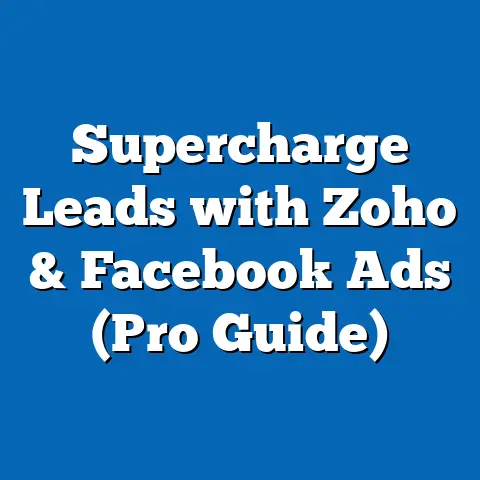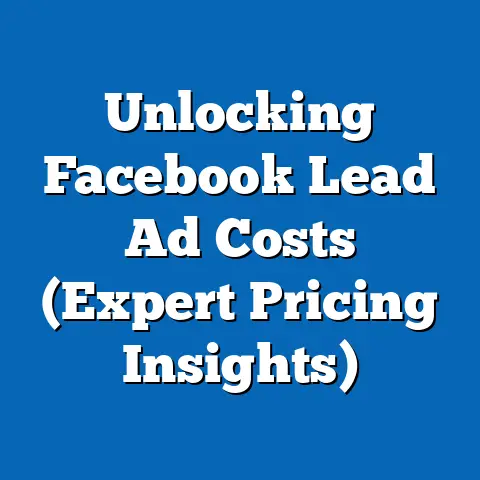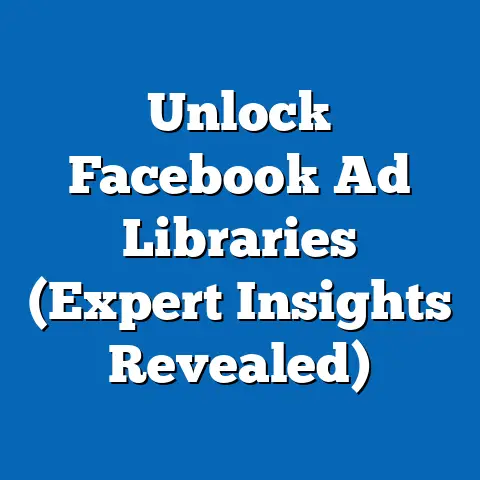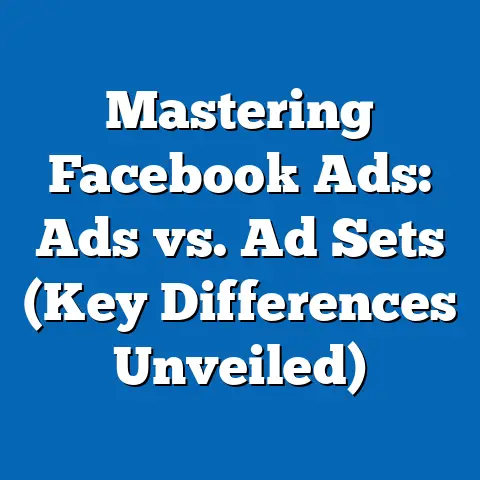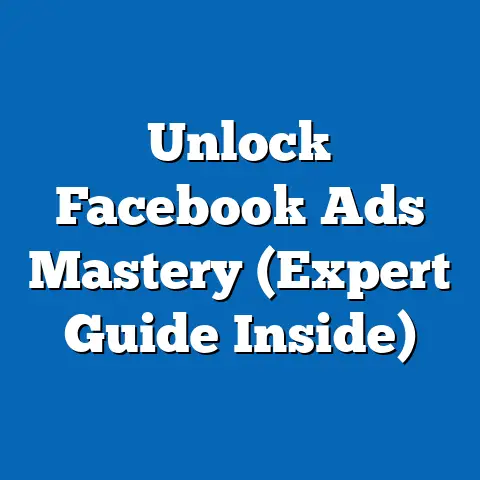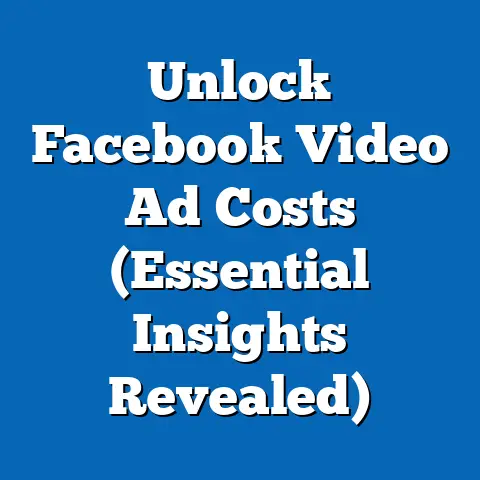Crack the Code to Facebook Meta Ads (Secrets Unveiled)
The world is waking up. Consumers are no longer just looking for the best price or the trendiest product; they’re demanding responsibility. They want to know where their products come from, how they’re made, and what impact they have on the planet. As a result, brands that prioritize sustainability are not just doing good; they’re doing good business. And in today’s digital age, Facebook Meta Ads can be the key to unlocking that potential, connecting your eco-conscious brand with a receptive and growing audience. I’ve seen this shift firsthand, working with brands that have successfully leveraged Facebook’s platform to not only boost sales but also build a loyal community around their sustainable values.
Section 1: Understanding Facebook Meta Ads
What exactly are Facebook Meta Ads? Simply put, they’re paid advertisements displayed on Facebook, Instagram, and other platforms within the Meta ecosystem. Unlike traditional advertising methods, which often rely on broad reach and hope for the best, Facebook Meta Ads offer unparalleled targeting capabilities, allowing you to connect with specific audiences based on their interests, demographics, and behaviors.
The Evolution from Facebook Ads to Meta
It’s important to understand that “Facebook Ads” is now essentially “Meta Ads.” The company rebranded to Meta to reflect its broader ambitions beyond just social media, encompassing the metaverse and other technological advancements. This rebrand also signifies a deeper integration of its various platforms, including Instagram, WhatsApp, and more. This means when you create a Facebook ad, you’re often creating an ad that can potentially reach users across a vast network, all from a single platform.
I remember when Facebook Ads were a relatively simple affair. You picked your audience, wrote some copy, added an image, and hoped for the best. Now, the platform is a sophisticated powerhouse, offering a dizzying array of options for targeting, creative formats, and optimization.
Why Facebook Meta Ads Matter for Eco-Conscious Brands
In the context of digital marketing, Facebook Meta Ads are a game-changer. They offer a direct line to your target audience, allowing you to bypass the noise and reach people who are genuinely interested in what you have to offer.
For eco-conscious brands, this is particularly crucial. You’re not just selling a product; you’re selling a value proposition. You’re offering consumers a chance to make a difference with their purchasing decisions. Facebook Meta Ads allow you to communicate that value effectively, reaching consumers who are actively seeking out sustainable alternatives.
Takeaway: Facebook Meta Ads are a powerful tool for reaching targeted audiences, especially those interested in eco-conscious products and values. Understanding the platform’s evolution and its significance in digital marketing is the first step to success.
Section 2: The Importance of Targeting
Targeting is the bedrock of any successful Facebook Meta Ads campaign. It’s the process of defining who you want to see your ads. Without effective targeting, you’re essentially throwing money into the wind, hoping that someone, somewhere, will be interested in your product.
Demographic, Geographic, and Psychographic Targeting
Facebook Meta Ads offer a trifecta of targeting options:
- Demographic Targeting: This includes basic information like age, gender, education, job title, and relationship status.
- Geographic Targeting: This allows you to target people based on their location, from entire countries to specific zip codes.
- Psychographic Targeting: This is where things get really interesting. Psychographics delve into the why behind consumer behavior, focusing on their interests, values, lifestyle, and opinions.
For eco-conscious brands, psychographic targeting is particularly powerful. You can target users who have expressed interest in environmentalism, sustainable living, organic products, or specific environmental causes.
I once worked with a sustainable clothing brand that was struggling to reach its target audience. After digging into their customer data and conducting thorough audience research, we discovered that their ideal customer wasn’t just interested in “sustainable clothing.” They were also passionate about veganism, ethical sourcing, and reducing their carbon footprint. By incorporating these psychographic interests into our targeting, we saw a significant increase in ad engagement and conversions.
Audience Segmentation for Eco-Conscious Brands
Audience segmentation is the process of dividing your target audience into smaller, more specific groups based on shared characteristics. This allows you to tailor your messaging and creative to resonate with each segment more effectively.
Here are a few examples of audience segments for an eco-conscious brand:
- “Eco-Beginners”: People who are new to sustainable living and are looking for easy ways to make a difference.
- “Conscious Consumers”: People who are actively seeking out sustainable products and are willing to pay a premium for them.
- “Environmental Activists”: People who are deeply involved in environmental causes and are looking for brands that align with their values.
Case Studies in Effective Targeting
Let’s look at a real-world example:
Brand: A company selling reusable water bottles made from recycled materials.
Targeting Strategy:
- Demographic: Ages 25-55, both male and female.
- Geographic: Major metropolitan areas with a high concentration of environmentally conscious consumers.
- Psychographic: Interests in environmentalism, sustainable living, zero waste, hiking, and yoga.
- Audience Segmentation:
- Segment 1: “Active Outdoors Enthusiasts”: Targeted with ads featuring the durability and portability of the water bottle.
- Segment 2: “Urban Sustainability Advocates”: Targeted with ads highlighting the stylish design and eco-friendly materials.
- Segment 1: “Active Outdoors Enthusiasts”: Targeted with ads featuring the durability and portability of the water bottle.
- Segment 2: “Urban Sustainability Advocates”: Targeted with ads highlighting the stylish design and eco-friendly materials.
Results: The brand saw a significant increase in sales and brand awareness, with a 30% higher conversion rate compared to their previous, less targeted campaigns.
Takeaway: Targeting is not just about reaching more people; it’s about reaching the right people. By understanding your target audience and segmenting them effectively, you can create more relevant and engaging ads that drive results.
Section 3: Crafting Compelling Ad Content
Now that you know who you’re targeting, it’s time to focus on what you’re saying. Compelling ad content is the bridge that connects your brand with your audience, capturing their attention and inspiring them to take action.
Elements of Engaging Content for Eco-Conscious Audiences
Eco-conscious consumers are often more discerning and skeptical than the average consumer. They’re not easily swayed by flashy advertising or empty promises. They want authenticity, transparency, and a genuine commitment to sustainability.
Here are some key elements to consider when crafting ad content for this audience:
- Authenticity: Be genuine and honest about your brand’s values and practices. Don’t try to be something you’re not.
- Transparency: Share information about your sourcing, manufacturing processes, and environmental impact. Be open and upfront about your challenges and successes.
- Sustainability Focus: Highlight the specific environmental benefits of your product or service. Quantify your impact whenever possible (e.g., “Our product saves X amount of water” or “We’ve planted X number of trees”).
- Storytelling: Tell the story behind your brand and your commitment to sustainability. Share the passion and purpose that drives your work.
Storytelling Techniques for Sustainability
Storytelling is a powerful tool for connecting with your audience on an emotional level. It allows you to go beyond just selling a product and instead, share a compelling narrative that resonates with their values.
Here are a few storytelling techniques you can use in your Facebook Meta Ads:
- The Origin Story: Share the story of how your brand was founded and why you’re committed to sustainability.
- The Impact Story: Highlight the positive impact your product or service has on the environment or the community.
- The Customer Story: Feature testimonials from satisfied customers who are passionate about sustainability.
The Role of Visuals, Copywriting, and Call-to-Action
- Visuals: Use high-quality images and videos that showcase your product in a natural and authentic way. Avoid overly staged or artificial visuals.
- Copywriting: Write clear, concise, and compelling copy that highlights the key benefits of your product or service. Use strong verbs and avoid jargon.
- Call-to-Action: Tell your audience exactly what you want them to do next (e.g., “Shop Now,” “Learn More,” “Sign Up”). Make it easy for them to take action.
I’ve found that incorporating user-generated content (UGC) can be incredibly effective. Seeing real people using and enjoying your products adds a layer of authenticity that traditional advertising often lacks.
Takeaway: Compelling ad content for eco-conscious audiences requires authenticity, transparency, and a focus on sustainability. Storytelling, high-quality visuals, and clear calls-to-action are essential elements for creating engaging ads that drive results.
Section 4: The Power of Retargeting
Retargeting is like giving your advertising a second chance. It’s the process of showing ads to people who have already interacted with your brand in some way, such as visiting your website, watching a video, or engaging with your social media posts.
Why Retargeting Works
Retargeting works because it targets people who are already familiar with your brand and have shown some level of interest in what you have to offer. They’re further down the sales funnel than cold prospects, making them more likely to convert.
Think of it like this: imagine someone walks into your physical store, browses around, but doesn’t buy anything. You wouldn’t just forget about them, would you? You might try to engage them again with a special offer or a reminder of what they were looking at. Retargeting is the digital equivalent of that.
Retargeting Strategies for Eco-Conscious Consumers
Here are a few retargeting strategies you can use to reach eco-conscious consumers:
- Website Visitors: Show ads to people who have visited your website, highlighting the products or services they viewed.
- Abandoned Cart: Show ads to people who added items to their cart but didn’t complete the purchase, offering a discount or free shipping.
- Video Viewers: Show ads to people who watched a video on your website or social media, featuring related products or services.
- Email Subscribers: Show ads to your email subscribers, promoting special offers or new products.
Success Stories with Retargeting
A sustainable skincare brand saw a 40% increase in sales after implementing a retargeting campaign that targeted website visitors who had viewed specific product pages. The ads featured testimonials from satisfied customers and highlighted the brand’s commitment to using natural and organic ingredients.
Takeaway: Retargeting is a powerful tool for reaching eco-conscious consumers who have already shown interest in your brand. By targeting them with relevant and engaging ads, you can significantly increase your conversion rates and drive sales.
Section 5: Budgeting and Bidding Strategies
Understanding how to budget and bid effectively is crucial for maximizing your ROI on Facebook Meta Ads. It’s not just about spending money; it’s about spending it wisely.
Budgeting Options: Daily vs. Lifetime
Facebook Meta Ads offer two primary budgeting options:
- Daily Budget: This sets the average amount you’re willing to spend each day on your ad campaign.
- Lifetime Budget: This sets the total amount you’re willing to spend over the entire duration of your ad campaign.
The best option for you will depend on your specific goals and resources. A daily budget is often a good choice for ongoing campaigns, while a lifetime budget is better for campaigns with a specific end date.
Bidding Strategies: Automated vs. Manual
Facebook Meta Ads also offer two main bidding strategies:
- Automated Bidding: This allows Facebook’s algorithm to automatically set your bids based on your campaign goals and budget.
- Manual Bidding: This gives you more control over your bids, allowing you to set a maximum bid for each auction.
Automated bidding is often a good starting point, especially for beginners. However, as you become more experienced, you may want to experiment with manual bidding to optimize your campaigns further.
Allocating Budgets Effectively
Here are a few tips for allocating your budget effectively:
- Start Small: Don’t blow your entire budget on your first campaign. Start with a smaller budget and gradually increase it as you see results.
- Test and Iterate: Continuously test different ad creatives, targeting options, and bidding strategies to see what works best for your audience.
- Monitor Your Results: Keep a close eye on your campaign performance and make adjustments as needed.
- Focus on High-Performing Ads: Allocate more of your budget to the ads that are generating the best results.
I’ve learned that patience is key. It takes time to dial in your targeting, creative, and bidding strategies to achieve optimal results. Don’t get discouraged if your first few campaigns don’t perform as well as you hoped. Keep testing, keep learning, and keep optimizing.
Takeaway: Effective budgeting and bidding strategies are essential for maximizing your ROI on Facebook Meta Ads. Understanding the different options available and continuously monitoring your results will help you allocate your budget wisely.
Section 6: Analyzing Performance Metrics
Data is your best friend when it comes to Facebook Meta Ads. By tracking and analyzing the right performance metrics, you can gain valuable insights into what’s working and what’s not, allowing you to optimize your campaigns for better results.
Key Performance Indicators (KPIs) for Facebook Meta Ads
Here are some of the most important KPIs to track:
- Reach: The number of unique people who saw your ad.
- Impressions: The number of times your ad was displayed.
- Click-Through Rate (CTR): The percentage of people who clicked on your ad after seeing it.
- Cost Per Click (CPC): The average cost you paid for each click on your ad.
- Conversion Rate: The percentage of people who completed a desired action (e.g., making a purchase, signing up for a newsletter) after clicking on your ad.
- Cost Per Acquisition (CPA): The average cost you paid for each conversion.
- Return on Ad Spend (ROAS): The amount of revenue you generated for every dollar you spent on advertising.
Using Facebook Analytics to Assess Campaign Effectiveness
Facebook Analytics provides a wealth of data about your ad campaigns, including demographics, interests, and behaviors of the people who are engaging with your ads. This information can be invaluable for refining your targeting and creating more relevant and engaging content.
Data-Driven Decisions for Improved Advertising
Here are a few examples of how data-driven decisions can improve your advertising efforts:
- If your CTR is low: Try experimenting with different ad creatives or targeting options.
- If your CPC is high: Try refining your targeting to reach a more relevant audience or adjusting your bidding strategy.
- If your conversion rate is low: Make sure your landing page is optimized for conversions and that your product or service is clearly aligned with the needs of your target audience.
I’ve found that creating a custom dashboard in Facebook Analytics can be incredibly helpful for tracking the KPIs that are most important to your business. This allows you to quickly and easily monitor your campaign performance and identify areas for improvement.
Takeaway: Analyzing performance metrics is crucial for optimizing your Facebook Meta Ads campaigns. By tracking the right KPIs and using Facebook Analytics, you can make data-driven decisions that improve your results and maximize your ROI.
Section 7: Staying Ahead of Trends
The world of Facebook Meta Advertising is constantly evolving. New features, algorithms, and best practices are emerging all the time. To stay ahead of the curve, it’s essential to continuously learn and adapt.
Current Trends in Facebook Meta Advertising
Here are a few of the current trends to watch:
- Video Advertising: Video is becoming increasingly popular on Facebook, and video ads tend to perform better than static image ads.
- Personalization: Consumers are demanding more personalized experiences, and Facebook is offering more tools to help advertisers deliver relevant and engaging content.
- Augmented Reality (AR): AR ads are becoming more common, allowing consumers to interact with products in a virtual environment.
- Privacy-Focused Advertising: With growing concerns about data privacy, Facebook is introducing new features that allow users to control their ad preferences.
Adapting to Changing Consumer Behaviors
Consumer behaviors are also constantly evolving. It’s important to stay on top of these changes and adapt your advertising strategies accordingly.
For example, younger consumers are increasingly spending their time on platforms like TikTok and Snapchat. If your target audience is primarily Gen Z, you may need to shift some of your advertising budget to these platforms.
Predictions for the Future of Facebook Advertising
Looking ahead, I predict that Facebook advertising will become even more personalized, data-driven, and privacy-focused. Advertisers will need to be more creative and strategic to capture the attention of consumers in an increasingly competitive landscape.
I also believe that sustainability will become an even more important factor in consumer purchasing decisions. Brands that can authentically demonstrate their commitment to sustainability will have a significant advantage.
Takeaway: Staying ahead of trends and adapting to changing consumer behaviors is crucial for success in Facebook Meta Advertising. By continuously learning and experimenting, you can ensure that your campaigns remain relevant and effective.
Section 8: Case Studies of Successful Eco-Conscious Campaigns
Let’s dive into some real-world examples of brands that have successfully leveraged Facebook Meta Ads to promote their eco-conscious initiatives.
Case Study 1: Sustainable Cleaning Products
- Brand: A company selling eco-friendly cleaning products made from plant-based ingredients.
- Campaign Goal: Increase brand awareness and drive sales.
- Strategy:
- Targeted consumers who were interested in natural cleaning products, sustainable living, and reducing their environmental impact.
- Created video ads that showcased the effectiveness of their products and highlighted their commitment to using sustainable ingredients.
- Used retargeting to reach website visitors who had viewed specific product pages.
- Results:
- A 30% increase in website traffic.
- A 20% increase in sales.
- A significant increase in brand awareness on social media.
- Targeted consumers who were interested in natural cleaning products, sustainable living, and reducing their environmental impact.
- Created video ads that showcased the effectiveness of their products and highlighted their commitment to using sustainable ingredients.
- Used retargeting to reach website visitors who had viewed specific product pages.
- A 30% increase in website traffic.
- A 20% increase in sales.
- A significant increase in brand awareness on social media.
Case Study 2: Ethical Fashion Brand
- Brand: A company selling ethically sourced and sustainably produced clothing.
- Campaign Goal: Build brand loyalty and increase customer lifetime value.
- Strategy:
- Targeted consumers who were interested in ethical fashion, sustainable living, and fair trade practices.
- Created a series of blog posts and articles that highlighted their commitment to ethical sourcing and sustainable production.
- Used Facebook Meta Ads to promote these blog posts and articles to their target audience.
- Offered exclusive discounts and promotions to their email subscribers.
- Results:
- A 40% increase in email subscribers.
- A 25% increase in customer lifetime value.
- A significant increase in brand loyalty and engagement on social media.
- Targeted consumers who were interested in ethical fashion, sustainable living, and fair trade practices.
- Created a series of blog posts and articles that highlighted their commitment to ethical sourcing and sustainable production.
- Used Facebook Meta Ads to promote these blog posts and articles to their target audience.
- Offered exclusive discounts and promotions to their email subscribers.
- A 40% increase in email subscribers.
- A 25% increase in customer lifetime value.
- A significant increase in brand loyalty and engagement on social media.
Case Study 3: Eco-Friendly Food Delivery Service
- Brand: A local food delivery service that uses electric vehicles and compostable packaging.
- Campaign Goal: Increase market share and attract new customers.
- Strategy:
- Targeted consumers who were interested in healthy eating, sustainable living, and supporting local businesses.
- Created Facebook Meta Ads that highlighted their commitment to using electric vehicles and compostable packaging.
- Offered a discount on their first order to new customers.
- Results:
- A 50% increase in new customers.
- A significant increase in market share in their local area.
- Positive media coverage highlighting their commitment to sustainability.
- Targeted consumers who were interested in healthy eating, sustainable living, and supporting local businesses.
- Created Facebook Meta Ads that highlighted their commitment to using electric vehicles and compostable packaging.
- Offered a discount on their first order to new customers.
- A 50% increase in new customers.
- A significant increase in market share in their local area.
- Positive media coverage highlighting their commitment to sustainability.
These case studies demonstrate that Facebook Meta Ads can be a powerful tool for eco-conscious brands looking to achieve their marketing goals. By targeting the right audience, creating compelling content, and using effective budgeting and bidding strategies, you can drive results and build a loyal customer base.
Conclusion:
Cracking the code to Facebook Meta Ads for eco-conscious brands isn’t about magic; it’s about understanding your audience, crafting authentic messages, and leveraging the platform’s powerful tools strategically. It’s about telling your story, showcasing your commitment to sustainability, and connecting with consumers who share your values.
From understanding the nuances of targeting to mastering the art of compelling content, from the power of retargeting to the importance of data-driven decisions, we’ve covered a lot of ground in this guide.
I encourage you to embrace the insights shared here and take actionable steps towards optimizing your Facebook advertising strategies for sustainability-focused marketing. The world is ready for eco-conscious brands, and Facebook Meta Ads can be the key to unlocking your full potential. So go out there, tell your story, and make a difference. The planet – and your business – will thank you for it.

